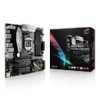Asus ROG STRIX Z270G GAMING STRIX Z270G GAMING Users manual ENGLISH - Page 23
Memory configurations, You may install 1 GB, 2 GB, 8 GB and 16 GB unbuffered and non-ECC DDR4 DIMMs
 |
View all Asus ROG STRIX Z270G GAMING manuals
Add to My Manuals
Save this manual to your list of manuals |
Page 23 highlights
Chapter 1 Memory configurations You may install 1 GB, 2 GB, 4 GB, 8 GB and 16 GB unbuffered and non‑ECC DDR4 DIMMs into the DIMM sockets. • You may install varying memory sizes in Channel A, and Channel B. The system maps the total size of the lower-sized channel for the dual-channel configuration. Any excess memory from the higher-sized channel is then mapped for single-channel operation. • Due to the memory address limitation on 32-bit Windows® OS, when you install 4GB or more memory on the motherboard, the actual usable memory for the OS can be about 3GB or less. For effective use of memory, we recommend that you do any of the following: a) Use a maximum of 3GB system memory if you are using a 32-bit Windows® OS. b) Install a 64-bit Windows® OS when you want to install 4 GB or more on the motherboard. c) For more details, refer to the Microsoft® support site at http://support.microsoft. com/kb/929605/en-us. • The design of the DIMM fan may vary. Ensure that the DIMM fan fits to the motherboard • The default memory operation frequency is dependent on its Serial Presence Detect (SPD), which is the standard way of accessing information from a memory module. Under the default state, some memory modules for overclocking may operate at a lower frequency than the vendor-marked value. • For system stability, use a more efficient memory cooling system to support a full memory load (4 DIMMs) or overclocking condition. • Memory modules with memory frequency higher than 2133MHz and their corresponding timing or the loaded XMP profile is not the JEDEC memory standard. The stability and compatibility of the memory modules depend on the CPU's capabilities and other installed devices. • Always install the DIMMS with the same CAS Latency. For an optimum compatibility, we recommend that you install memory modules of the same version or data code (D/C) from the same vendor. Check with the vendor to get the correct memory modules. • ASUS exclusively provides hyper DIMM support function. • Hyper DIMM support is subject to the physical characteristics of individual CPUs. Load the X.M.P. or D.O.C.P. settings in the BIOS for the hyper DIMM support. • Visit the ASUS website for the latest QVL. ROG STRIX Z270G GAMING 1-7















